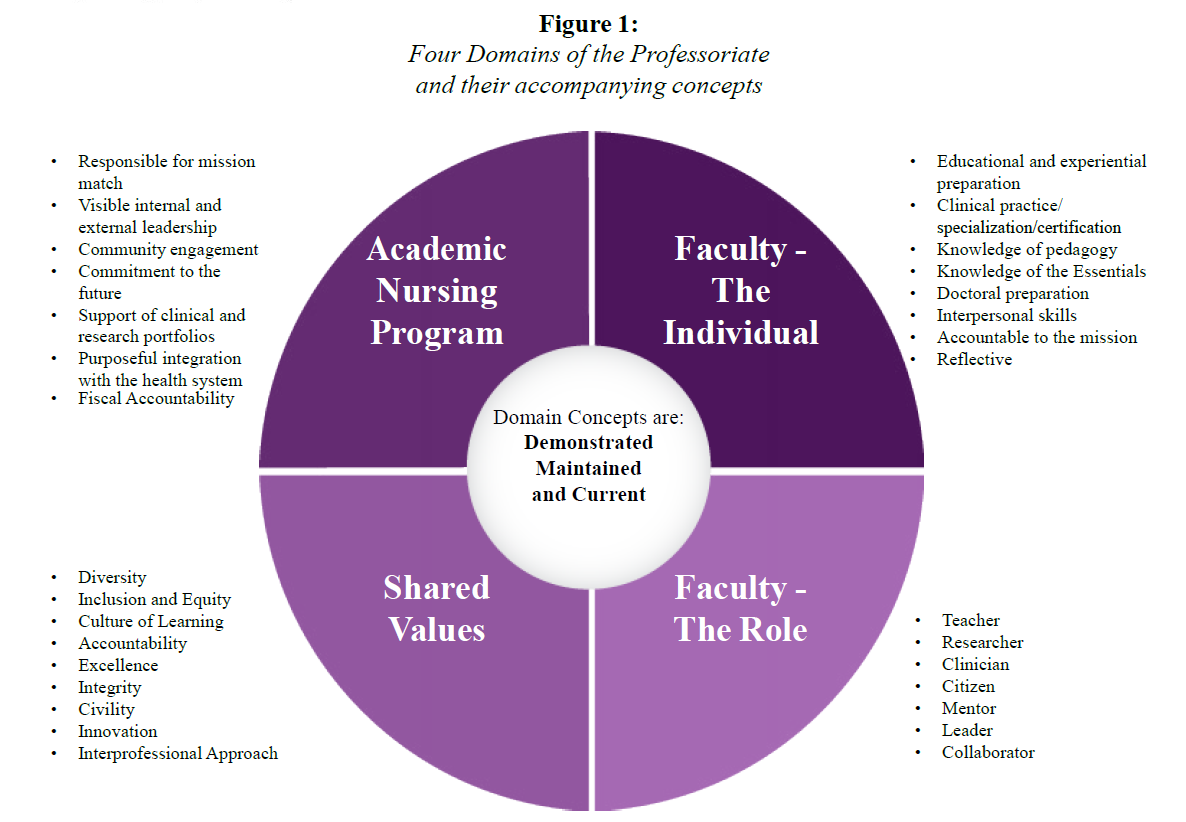Download PDF Version
The professoriate of the future is educationally and experientially prepared to teach students and professional nurses to lead change, spur innovation, and transform health care. Significant changes in nursing, the health professions, and higher education have impacted the expectations of faculty, including who is being recruited to schools of nursing and how they teach. Faculty must balance their roles as educators, clinicians, and researchers, as well as be nimble to meet the opportunities presented by an evolving healthcare system, diverse patient and student populations, advances in educational technology, shifts in learner expectations, and the need to impact policy locally and beyond. These changes require close examination of the requirements to serve in faculty roles.
The vision of the professoriate for the future entails four domains: the faculty as the individual, the roles they occupy, their shared values, and the role of the academic nursing program in creating an intellectual environment that fosters professional growth whereby faculty and students feel nurtured and mentored (as depicted in Figure 1). For each of these four domains, it is vital that the concepts included are demonstrated, maintained, and remain current (see Figure 1). To meet the demand for high quality faculty in baccalaureate and graduate nursing programs, the American Association of Colleges of Nursing (AACN) endorses the following preferred vision of the nursing professoriate.
Faculty as the Individual
Faculty as the individual represents a comprehensive look at the educational and experiential preparation of the nursing professoriate including clinical practice, specialization, and certification. The individual faculty, from nursing or other disciplines, will demonstrate current and sustained competency in knowledge of the AACN Essentials appropriate for the baccalaureate and graduate level teaching, pedagogy, interpersonal skills, and leadership as well as competency in their area of practice/specialization.
Doctoral education is the preferred terminal degree for the professoriate so that it continues to advance each academic institution’s mission, which may include any combination of scholarship in education, practice, and research as well as service. To that end, the research doctorate or the practice doctorate have distinct contributions. The choice of the doctoral degree depends upon the candidates’ career path and the scholarship they intend to contribute. The minimal expectation for clinical instruction, coordination, and mentoring of preceptors is having obtained clinically focused graduate preparation and maintenance of currency in practice.
The faculty must balance their stature within the academy with their concurrent responsibility to prepare graduates for the workforce. Therefore, the mix of faculty’s educational preparation, expertise, roles, and responsibilities will vary according to the mission of the academic program. Regardless of the career path the faculty takes as an educator, they are accountable for the professional standards, ethics, and collegiality that is essential to lead and work in interprofessional teams.
Faculty Roles
The role of nursing faculty is multi-dimensional and requires demonstrated and sustained scholarship in education, research, practice, and/or leadership. Each of these components requires balance according to the needs of the profession, the institution, school, and programs. Within each of these components, the faculty assume a leadership role to mentor students and other faculty, engage in intra- and inter-professional collaboration, spur innovative curriculum development and learning modalities/resources, support shared governance, and pursue academic partnerships. The faculty also serve as change agents and provide leadership in the program, within the academy, and externally in professional organizations and communities of interest.
Shared Values
Shared values are the fundamental beliefs of faculty that guide decisions and behavior. Faculty as scholars share common values such as a commitment to inclusion and diversity, integrity, equity, and accountability. Furthermore, faculty dedicate themselves to enhancing and modeling a culture of learning in which lifelong learning, knowledge, and respect for worldviews beyond their own and the nursing profession are valued and cultivated. Implicit in shared values are the concepts of excellence in research, practice, and education, and integrity in all interactions. Professional behavior mandates civility, respect, dignity, and a scholarly demeanor.
Academic Nursing Program
The academic nursing program, under the guidance of the dean/chair/director, provides the infrastructure, resources, and milieu in which faculty work and flourish. This environment fosters a commanding and comprehensive vision based on internal/external trends, facilitates community engagement, and supports a range of clinical, educational, and research foci tailored to the larger environmental context. The academic program enables faculty to meet current, emerging, and future healthcare needs of populations through purposeful integration with the higher education institution, health systems, and communities of interest.

Endorsed on October 30, 2017 by AACN Members